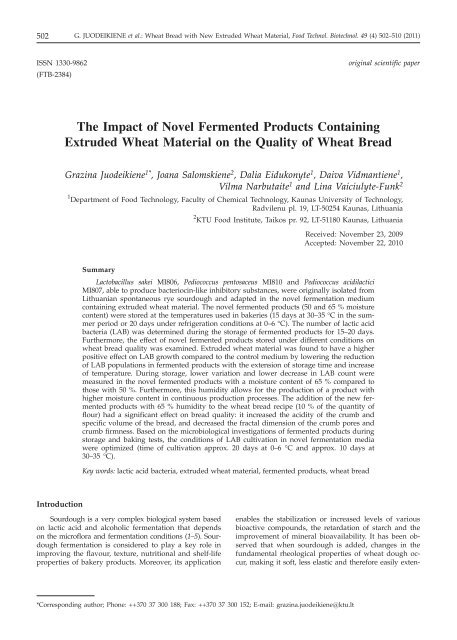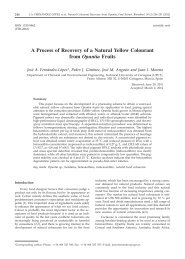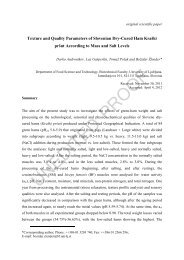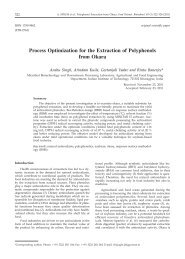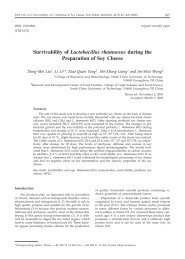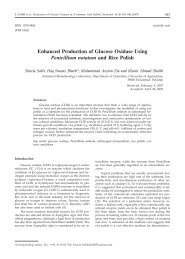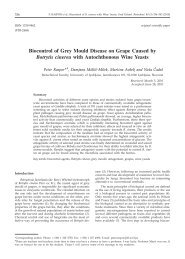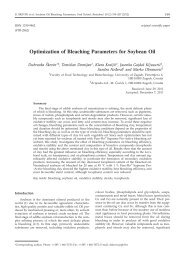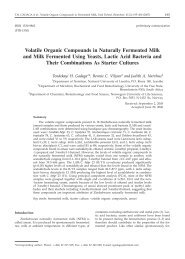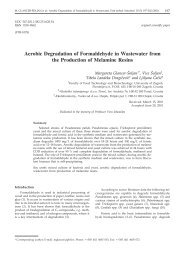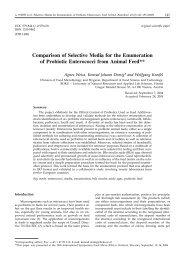The Impact of Novel Fermented Products Containing Extruded ...
The Impact of Novel Fermented Products Containing Extruded ...
The Impact of Novel Fermented Products Containing Extruded ...
You also want an ePaper? Increase the reach of your titles
YUMPU automatically turns print PDFs into web optimized ePapers that Google loves.
502 G. JUODEIKIENE et al.: Wheat Bread with New <strong>Extruded</strong> Wheat Material, Food Technol. Biotechnol. 49 (4) 502–510 (2011)ISSN 1330-9862(FTB-2384)original scientific paper<strong>The</strong> <strong>Impact</strong> <strong>of</strong> <strong>Novel</strong> <strong>Fermented</strong> <strong>Products</strong> <strong>Containing</strong><strong>Extruded</strong> Wheat Material on the Quality <strong>of</strong> Wheat BreadGrazina Juodeikiene 1* , Joana Salomskiene 2 , Dalia Eidukonyte 1 , Daiva Vidmantiene 1 ,Vilma Narbutaite 1 and Lina Vaiciulyte-Funk 21 Department <strong>of</strong> Food Technology, Faculty <strong>of</strong> Chemical Technology, Kaunas University <strong>of</strong> Technology,Radvilenu pl. 19, LT-50254 Kaunas, Lithuania2 KTU Food Institute, Taikos pr. 92, LT-51180 Kaunas, LithuaniaReceived: November 23, 2009Accepted: November 22, 2010SummaryLactobacillus sakei MI806, Pediococcus pentosaceus MI810 and Pediococcus acidilacticiMI807, able to produce bacteriocin-like inhibitory substances, were originally isolated fromLithuanian spontaneous rye sourdough and adapted in the novel fermentation mediumcontaining extruded wheat material. <strong>The</strong> novel fermented products (50 and 65 % moisturecontent) were stored at the temperatures used in bakeries (15 days at 30–35 °C in the summerperiod or 20 days under refrigeration conditions at 0–6 °C). <strong>The</strong> number <strong>of</strong> lactic acidbacteria (LAB) was determined during the storage <strong>of</strong> fermented products for 15–20 days.Furthermore, the effect <strong>of</strong> novel fermented products stored under different conditions onwheat bread quality was examined. <strong>Extruded</strong> wheat material was found to have a higherpositive effect on LAB growth compared to the control medium by lowering the reduction<strong>of</strong> LAB populations in fermented products with the extension <strong>of</strong> storage time and increase<strong>of</strong> temperature. During storage, lower variation and lower decrease in LAB count weremeasured in the novel fermented products with a moisture content <strong>of</strong> 65 % compared tothose with 50 %. Furthermore, this humidity allows for the production <strong>of</strong> a product withhigher moisture content in continuous production processes. <strong>The</strong> addition <strong>of</strong> the new fermentedproducts with 65 % humidity to the wheat bread recipe (10 % <strong>of</strong> the quantity <strong>of</strong>flour) had a significant effect on bread quality: it increased the acidity <strong>of</strong> the crumb andspecific volume <strong>of</strong> the bread, and decreased the fractal dimension <strong>of</strong> the crumb pores andcrumb firmness. Based on the microbiological investigations <strong>of</strong> fermented products duringstorage and baking tests, the conditions <strong>of</strong> LAB cultivation in novel fermentation mediawere optimized (time <strong>of</strong> cultivation approx. 20 days at 0–6 °C and approx. 10 days at30–35 °C).Key words: lactic acid bacteria, extruded wheat material, fermented products, wheat breadIntroductionSourdough is a very complex biological system basedon lactic acid and alcoholic fermentation that dependson the micr<strong>of</strong>lora and fermentation conditions (1–5). Sourdoughfermentation is considered to play a key role inimproving the flavour, texture, nutritional and shelf-lifeproperties <strong>of</strong> bakery products. Moreover, its applicationenables the stabilization or increased levels <strong>of</strong> variousbioactive compounds, the retardation <strong>of</strong> starch and theimprovement <strong>of</strong> mineral bioavailability. It has been observedthat when sourdough is added, changes in thefundamental rheological properties <strong>of</strong> wheat dough occur,making it s<strong>of</strong>t, less elastic and therefore easily exten-*Corresponding author; Phone: ++370 37 300 188; Fax: ++370 37 300 152; E-mail: grazina.juodeikiene@ktu.lt
G. JUODEIKIENE et al.: Wheat Bread with New <strong>Extruded</strong> Wheat Material, Food Technol. Biotechnol. 49 (4) 502–510 (2011)503sible (6). Microbial spoilage limits the shelf life <strong>of</strong> foodstuffs,therefore sourdough addition is the most promisingapplication to control mould growth and ropiness inwheat bread products (7,8).In sourdough ecosystems, lactic acid bacteria (LAB)(9) and yeasts constitute the dominant micr<strong>of</strong>lora andcontribute not only to the development <strong>of</strong> the desiredsensorial properties <strong>of</strong> the final product but also to itsmicrobiological safety, either as the natural micr<strong>of</strong>lora oras starter cultures added under controlled conditions.<strong>The</strong> initial counts <strong>of</strong> LAB in rye or wheat sourdoughsare up to 3·10 9 colony forming units (CFU) per g or5·10 8 –1·10 9 CFU/g, respectively (10). However, the number<strong>of</strong> LAB in rye and wheat sourdough depends on theproperties <strong>of</strong> dough, starter cultures and fermentation conditions(4,10). Sourdough fermentation is evaluated bythe following parameters: pH, acidity and micr<strong>of</strong>lora composition(11,12). <strong>The</strong> main factor regulating acidificationis the amount <strong>of</strong> fermentable carbohydrates. <strong>The</strong> production<strong>of</strong> acids also depends on the fermentation temperature,time and dough yield: higher temperature, higherwater content <strong>of</strong> sourdough and the use <strong>of</strong> wholemealflour enhance the production <strong>of</strong> acids in the sourdough(13,14). Acidification <strong>of</strong> the dough, proteolysis <strong>of</strong> glutenand moderate hydrolysis <strong>of</strong> starch are LAB activities thatvary among sourdough strains and may affect the physicochemicalchanges throughout the shelf life <strong>of</strong> bread(15). Analysis <strong>of</strong> structures such as bread cell networksby means <strong>of</strong> fractal geometry may provide useful informationfor finding relationships between structure functionalityand processing variables (16,17).Until now, the main focus has been given to the naturalantimicrobials produced by LAB such as organicacids, hydrogen peroxide, CO 2 , diacetyl, acetaldehyde,D-isomers <strong>of</strong> amino acids and reuterin. Over the last fewyears, there has been an explosion <strong>of</strong> basic and appliedresearch on extracellularly released and ribosomallysynthesized proteinaceous compounds – bacteriocins,produced by LAB and exhibiting bactericidal and/orbacteriostatic modes <strong>of</strong> action against closely related speciesand even foodborne pathogens. <strong>The</strong> highly promisingresults <strong>of</strong> these studies underline the potentialapplication <strong>of</strong> bacteriocinogenic LAB strains in the foodindustry as starter cultures, cocultures, or bioprotectivecultures to improve food quality and safety. Nevertheless,the literature lacks updated reviews dealing withthe antimicrobial activity <strong>of</strong> bacteriocins or bacteriocin--producing LAB against ropiness caused by Bacillus subtilisand other bacteria in order to increase the stability<strong>of</strong> sourdough. <strong>The</strong> structural genes <strong>of</strong> LAB are responsiblefor the antimicrobial activity <strong>of</strong> the strains. Furthermore,according to the literature, the production <strong>of</strong> LABmetabolites may be intensified by applying the appropriatefermentation media. In the Baltic States, a traditionalprocess <strong>of</strong> scalding (a process <strong>of</strong> heat treatment <strong>of</strong>flour matrix with hot water or steam that brings it tostarch gelatinization) is applied in the production <strong>of</strong>bread. However, scalded bread preparation is a long,complicated and economically inefficient process. <strong>The</strong>alternative technological means for the intensification <strong>of</strong>sourdough production, its higher stability and improvedbread quality are still being sought. To attain these goals,new prospects have become available by developing thistechnology for the industrial production <strong>of</strong> fermentedproducts with antimicrobial properties. Recently, considerableinterest has arisen in the application <strong>of</strong> new fermentationmedia such as extruded products possessingspecific physical properties (higher amounts <strong>of</strong> dietaryfibre). Extrusion cooking causes gelatinization <strong>of</strong> starchamong other physicochemical and functionality changesthe grain components undergo; moreover, this results inthe enhanced amount <strong>of</strong> dietary fibre and the elimination<strong>of</strong> the bacterial contamination <strong>of</strong> cereal material.However, there is lack <strong>of</strong> literature data on the effect <strong>of</strong>extruded wheat material on lactic acid bacteria cultivationprocesses under different conditions for the industrialsourdough production and the influence <strong>of</strong> fermentedproducts on wheat bread quality.<strong>The</strong> objective <strong>of</strong> this study is to adapt selected LABwith antimicrobial properties into novel fermentationmedia prepared with extruded wheat material. Furtheressential point <strong>of</strong> the study is the determination <strong>of</strong> theimpact <strong>of</strong> novel fermented products on wheat breadquality.Materials and MethodsMicroorganisms and culture conditionsLactobacillus sakei MI806, Pediococcus pentosaceusMI810 and Pediococcus acidilactici MI807, able to producebacteriocin-like inhibitory substances (BLIS) designatedas sakacin 806, pediocin 810 and pediocin Ac807, respectively,were used throughout the study. <strong>The</strong>y wereoriginally isolated from Lithuanian sourdough (18) andtheir bacteriocin activity was confirmed (19). Strainswere stored at –70 °C in a Microbank TM system (Pro-LabDiagnostics, Bromborough, Wirral, Merseyside, UK) andwere later propagated in DeMan, Rogosa and Sharpe(MRS) broth (CM 0359, Oxoid Ltd, Basingstoke, Hampshire,UK) at 30 °C (MI806) or 35 °C (MI810 and MI807)for 72 h. Sourdough starter and fermented products(sourdough) for wheat bread baking were made using asingle culture from the three selected LAB.Fermentation medium<strong>The</strong> extruded wheat material, obtained from UstukiuMalunas Ltd., Lithuania, was produced using asingle-screw extruder with a 1´3 mm nozzle. <strong>The</strong> extrusionparameters during the experiment were constant:screw speed 470 rpm, feed rate 150 kg/h, water dosage10 kg/h and temperature in the individual zones 45, 65and 135 o C. Moisture content, water absorption index(WAI) and water solubility index (WSI) <strong>of</strong> the extrudedsamples were determined following the method describedpreviously (20,21). Wheat flour (type 550C, ash content0.51–0.57 %, falling number 350 s and moisture content14.5 %) was obtained from Kauno Grudai Ltd., Lithuania,and was used as control for bread-baking experiments.<strong>The</strong> extruded wheat flour had the following characteristics:moisture content 8.6 %, WAI 2.2 g/g, andWSI 10.8 %.
504 G. JUODEIKIENE et al.: Wheat Bread with New <strong>Extruded</strong> Wheat Material, Food Technol. Biotechnol. 49 (4) 502–510 (2011)Preparation <strong>of</strong> sourdough starter and fermentedproductsA four-stage fermentation process for the inoculation<strong>of</strong> lactic acid bacteria cultures into extruded wheatmaterial was used (Fig. 1). A continuous propagation(after 4, 20 and 44 h) was adjusted in order to keep themicroorganisms in an active metabolic state. <strong>The</strong> fermentationprocess during sourdough starter productionwas carried out at temperatures optimal for the strainsused: L. sakei at 30 °C, P. pentosaceus and P. acidilactici at35 °C.<strong>Fermented</strong> products were prepared by adding sourdoughstarter, using a single culture <strong>of</strong> LAB, to the extrudedwheat material mass (50 or 65 % moisture content)(Fig. 1, 5th stage). <strong>The</strong> fermentation process wascarried out for 24 h at an optimal temperature for theLAB. In this stage, fermented products can be used forbread production. In the case <strong>of</strong> industrialized production<strong>of</strong> fermented products, further microbiological processesand their effect on wheat bread quality dependon bakery storage conditions (room temperature in thesummer or in the refrigerator). Based on this elaborateprocedure, prepared fermented products were stored attwo different temperature regimes: at 30–35 °C for 10days or at 0–6 °C up to 20 days during the experiment.Microbiological analysis<strong>The</strong> effect <strong>of</strong> a novel fermentation medium on thegrowth <strong>of</strong> LAB was determined by estimating theirnumber in the newly prepared fermented products andafter storage for 5, 10, 15 and 20 days. LAB counts infermented product samples were determined on MRSagar (Li<strong>of</strong>ilchem, Roseto degli Abruzzi, Teramo, Italy)using plate count techniques. Plates were incubated for(48±4) h under anaerobic conditions. <strong>The</strong> number <strong>of</strong> LABwas expressed as decimal logarithmic value <strong>of</strong> colonyforming units per gram (log CFU/g). <strong>The</strong> experimentwas run in triplicate.Wheat bread makingWheat bread samples were baked on the 1st, 5th,10th, 15th and 20th day after the storage <strong>of</strong> the fermentedproduct under different temperature conditions. Wheatbread samples containing fermented product (moisturecontent <strong>of</strong> 65 %) 10 % <strong>of</strong> the quantity <strong>of</strong> flour were preparedusing a laboratory baking device (automatic GermaticBM-2 oven, AFK, Hamburg, Germany). Breadsamples were baked under the following program: mixingfor 10 min, first pro<strong>of</strong>ing for 25 min at 25 °C, mixingfor 15 min at 30 °C, second pro<strong>of</strong>ing for 35 min at 32 °C,third pro<strong>of</strong>ing for 70 min at 38 °C, and baking for 55min at 121 °C. <strong>Fermented</strong> products made from wheatflour with LAB, and baked goods produced without theaddition <strong>of</strong> extruded material (using only wheat flour)were analyzed as control samples. <strong>The</strong> bread quality wasevaluated 17 h after baking.Bread quality evaluationTotal titratable acidity (TTA) <strong>of</strong> the fermented productsand bread crumbs was measured according to themethod described in AACC (22). <strong>The</strong> TTA value was expressedin milliliters <strong>of</strong> 0.1 M NaOH solution used per10 g <strong>of</strong> sample to obtain pH=8.5. <strong>The</strong> specific volume <strong>of</strong>the bread samples was evaluated as described in AACC(22).Fractal and image analysis <strong>of</strong> wheat bread bubbledistribution<strong>The</strong> analysis was performed following the methoddescribed by Calderón-Domínguez et al. (16). Twenty--four bread loaves were sliced using an electrical cutterin three pieces for each sample. <strong>The</strong> image and fractalanalysis were performed using image analysis systemand image public domain s<strong>of</strong>tware (National Institutes<strong>of</strong> Health, Bethesda, MD, USA). Images <strong>of</strong> bread sliceswere scanned in RBG colour and saved in a bmp for-StartercultureFermentationmediaWaterI. FERMENTATION STAGE(4 h at the optimal temperature <strong>of</strong> the strain)SOURDOUGHSTARTERPRODUCTIONII. FERMENTATION STAGE(18 h at the optimal temperature <strong>of</strong> the strain)III. FERMENTATION STAGE(24 h at the optimal temperature <strong>of</strong> the strain)+ fermentationmedia andwater (1:2)IV. FERMENTATION STAGEV. STAGE: PRODUCTION OFFERMENTED PRODUCT<strong>Extruded</strong> flour +water (50or65%moisture content)Fig. 1. Scheme <strong>of</strong> production <strong>of</strong> sourdough starter and fermented products
G. JUODEIKIENE et al.: Wheat Bread with New <strong>Extruded</strong> Wheat Material, Food Technol. Biotechnol. 49 (4) 502–510 (2011)505mat. <strong>The</strong> RGB colour images were converted to greylevel and binary images using the ImageJ s<strong>of</strong>tware. <strong>The</strong>characteristics <strong>of</strong> crumbs selected from each image fieldwere: number <strong>of</strong> cells/cm 2 , cell maximal perimeter (P)defined as the length <strong>of</strong> all pixels along the boundaries<strong>of</strong> a specified image object, and the area <strong>of</strong> single cells(A) in pixels. Cell shape for each pore was analyzed usingfractal dimension (FD cell )asfollows(23):FD cell =2·ln(P/4)/ln(A) /1/individual P and A values were used to evaluate FD celland were reported as the average value <strong>of</strong> individual dimensions<strong>of</strong> the measured pores.Bread crumb firmness was determined as a maximumcompression force (60 % compression with 10-mmdiameter plunger, compression rate 2 mm/s) using aStevens LFRA Texture Analyzer (Leatherhead Food ResearchAssociation, Leatherhead, Surrey, UK).Statistical analysisAll the experiments were carried out in at leastthree independent experiments. <strong>The</strong> mean calculationsfor the obtained raw data were calculated and indicatedtogether with the standard deviation. LAB counts wereconverted into decimal logarithmic values to closelymatch the assumption <strong>of</strong> a normal distribution. <strong>The</strong> obtaineddata were analyzed using the statistical packageSPSS v. 15.0 for Windows (IBM, Armonk, NY, USA), forcorrelation coefficient and regression analyses. <strong>The</strong> significance<strong>of</strong> each instrumental measurement/descriptiveattribute in discriminating between the samples wasanalyzed using an analysis <strong>of</strong> variance (ANOVA). <strong>The</strong>significance <strong>of</strong> differences was evaluated using Tukey'smultiple range test at a5%level.Results and DiscussionMicrobiological analysis <strong>of</strong> fermented product<strong>The</strong> microbiological analysis <strong>of</strong> fermented productsamples made under laboratory conditions revealed thatL. sakei, P. pentosaceus and P. acidilactici counts rangedfrom 6.05 to 9.85, from 4.32 to 10.72 and from 4.51 to9.88 log CFU/g, respectively (Fig. 2). <strong>The</strong> fermentationmedium was found to have a significant effect (p
506 G. JUODEIKIENE et al.: Wheat Bread with New <strong>Extruded</strong> Wheat Material, Food Technol. Biotechnol. 49 (4) 502–510 (2011)a)N(LAB)/(log CFU/g)b)N(LAB)/(log CFU/g)1110987654111098765450 65 50 65 50 65L.s. P.p. P.a.w(moisture)/%t/day15t/day1510152050 65 50 65 50 65L.s. P.p. P.a.w(moisture)/%1015Fig. 3. <strong>The</strong> effect <strong>of</strong> moisture content <strong>of</strong> extruded wheat mediaon the changes <strong>of</strong> the number <strong>of</strong> L. sakei (L.s.), P. pentosaceus(P.p.) and P. acidilactici (P.a.) during storage <strong>of</strong> fermented productsat: a) 0–6 °C and b) 30–35 °CHowever, during the storage <strong>of</strong> fermented products, itwas noticed that the more liquid medium (65 %) generallyshowed lower decrease in LAB count. <strong>The</strong> reductionin LAB count in 50 % extruded wheat material within 15days (30–35 °C) and 20 days (0–6 °C) <strong>of</strong> storage was foundon average by 50 and 13.5 %, respectively, while in the65 % fermentation medium, this parameter decreased by28 and 7 %, respectively. Moreover, the lower variation<strong>of</strong> LAB count was measured in the fermented productswith the higher moisture content.In this study most <strong>of</strong> the samples contained LABcounts within the range reported by other authors (24–26). <strong>The</strong> LAB count during fermentation was reported toincrease to some level, followed by a decrease afterwards(27,28). This can be explained by four different bacterialgrowth phases: lag phase, exponential or log phase, stationaryphase and death phase. <strong>The</strong>re is some controversyabout the effect <strong>of</strong> fermentation medium moisturecontent on LAB growth. Wang et al. (29) reported thatlactic acid bacteria survive better at low water activity,while Hansen and Schieberle (2) stated that a mediumwith high water content was more proper for the LABcultivation due to the solubility <strong>of</strong> nutrients in the medium.Nevertheless, microorganisms are found to be verysensitive to the changes in the water content and nutrientconcentration. <strong>The</strong> direct addition <strong>of</strong> selected startercultures to raw materials is the highlight <strong>of</strong> the production<strong>of</strong> fermented foods, helping to control the overallstandardization <strong>of</strong> the fermentation process and quality<strong>of</strong> the end product (24).Bread quality evaluationTotal titratable acidity (TTA)<strong>The</strong> results <strong>of</strong> total titratable acidity showed thatTTA values <strong>of</strong> fermented products ranged from 9.3 to27.7 on the first day <strong>of</strong> the experiment (Fig. 4a). In allsamples, the TTA values increased with increased storagetime and temperature. <strong>The</strong> application <strong>of</strong> extrudedmaterial in the preparation <strong>of</strong> the products fermentedwith L. sakei, P. pentosaceus and P. acidilactici, stored for20 days at 0–6 °C, influenced the increase in TTA valuesby an average <strong>of</strong> 39 % as compared to the control samples.<strong>The</strong> TTA pr<strong>of</strong>ile <strong>of</strong> the fermented products after 15days <strong>of</strong> storage at 30–35 °C was higher by an average <strong>of</strong>22 % (starters continued to produce acids more intensively)than TTA values measured in the samples storedat 0–6 °C. A considerable increase in TTA by 50 and 55% was noticed in the samples with P. acidilactici fromday 10 to day 15 <strong>of</strong> storage at temperatures rangingfrom 0–6 °C and 30–35 °C, respectively.In parallel, a comparable TTA <strong>of</strong> wheat bread bakedwith fermented products was evaluated (Fig. 4b) andcommensurate trends were noticed. <strong>The</strong> highest TTAlevels (2.9–3.9) were measured in the bread samplesbaked with novel P. pentosaceus-fermented productsstored at 0–6 °C. Bread samples containing the productsfermented with L. sakei and P. acidilactici were found tohave lower acidity levels, ranging from 1.2 to 1.97 andfrom 1.3 to 3.53, respectively, as compared to the breadsamples prepared with the P. pentosaceus-fermented products.A slight increase in TTA values with the increasingstorage time, and the highest TTA values <strong>of</strong> samplesstored at 30–35 °C were observed. <strong>The</strong> following statementscan be inferred according to the TTA results <strong>of</strong>bread samples with the fermented products preparedwith the extruded material and L. sakei, P. pentosaceus orP. acidilactici. <strong>The</strong> TTA values <strong>of</strong> bread produced usingthe products fermented with L. sakei, P. pentosaceus or P.acidilactici and stored for 20 days at 0–6 °C increased by36, 17 and 69 %, respectively, while in bread sampleswith fermented products stored for 15 days at 30–35 °Cthey increased by 39, 25 and 74 %, respectively.<strong>The</strong> acidification activity <strong>of</strong> LAB contributes to thebeneficial properties <strong>of</strong> fermented products. Typical TTAvalues <strong>of</strong> acidic wheat sourdough were reported to be8–13 (2,30), while in wholemeal and rye sourdough theTTA values were in the range <strong>of</strong> 16–22 and 15–26, respectively(31). As reported by other authors, higher temperature,higher water content <strong>of</strong> fermented productsand the utilization <strong>of</strong> whole meal flour enhance the production<strong>of</strong> acids in wheat sourdough (4,32). Katina (27)reported about the significant interaction <strong>of</strong> fermentationtime and temperature on the formation <strong>of</strong> acidity inLAB-fermented sourdough, indicating that high levels <strong>of</strong>
G. JUODEIKIENE et al.: Wheat Bread with New <strong>Extruded</strong> Wheat Material, Food Technol. Biotechnol. 49 (4) 502–510 (2011)507a)TTA(fermented products)40353025201510L. sakeiP. pentosaceusP. acidilacticicontroln/(cm /g)33.53.02.52.01.5L. sakeiP. pentosaceusP. acidilacticicontrol51.0b)TTA(bread)04.543.532.521.510.504 30 4 30 4 30 4 30 4Temperature/°C1 5 10 15 20t(storage)/dayL. sakeiP. pentosaceusP. acidilacticicontrol4 30 4 30 4 30 4 30 4Temperature/°C1 5 10 15 20t(storage)/dayFig. 4. <strong>The</strong> influence <strong>of</strong> storage time and temperature on TTA<strong>of</strong>: a) fermented products and b) bread, fermented with L. sakei,P. pentosaceus and P. acidilacticiacidity in sourdough required both elevated temperaturelevels and longer fermentation time, and preferablythe use <strong>of</strong> flour with a high ash content. <strong>The</strong> main factorregulating acidification is the amount <strong>of</strong> fermentablecarbohydrates (33), although the production <strong>of</strong> acids dependsalso on other things such as fermentation temperature,time and dough yield (27). <strong>The</strong> results obtainedin the microbiological study confirmed that extrudedmaterial can be effective in a beneficial modification <strong>of</strong>the fermentation process by intensification <strong>of</strong> the growth<strong>of</strong> LAB and increase <strong>of</strong> the acidity level in bread samples.0.50.04 30 4 30 4 30 4 30 4Temperature/°C1 5 10 15 20t(storage)/dayFig. 5. <strong>The</strong> influence <strong>of</strong> storage time and temperature on theproducts fermented with L. sakei (L.s.), P. pentosaceus (P.p.) andP. acidilactici (P.a.) on the specific volume <strong>of</strong> bread samplesSpecific volumeIn all the tested bread samples a decrease in specificvolume with the increasing storage time and highertemperature <strong>of</strong> fermented products was noticed (Fig. 5).<strong>The</strong> bread samples with novel fermented products madeusing P. pentosaceus stored for 15 days at 0–6 °C or 10days at 30–35 °C were found to have the highest specificvolume ((2.95–3.41) cm 3 /g) (Fig. 5).<strong>The</strong> most considerable reduction in specific volume,by 16 and 19 % on average, was measured in breadsamples prepared with the control products (without extrudedproducts) stored for 15 days at 30–35 and 0–6 °C,respectively. With the increasing storage time <strong>of</strong> fermentedproducts containing extruded material, a lessnegative effect (decrease by 7 %) on the quality <strong>of</strong> breadwas noticed, as compared to the reference samples. Breadsamples produced with novel fermented products madefrom extruded wheat material fermented by L. sakei andP. acidilactici were found to have the most stable quality.<strong>The</strong>se results are in agreement with the previous datathat extruded wheat material had a higher positive effecton LAB growth compared to the control medium(Fig. 2) as well as on the increase <strong>of</strong> the acidificationpr<strong>of</strong>ile in novel fermentation medium (Fig. 4).Sadeghi et al. (34) published contrary results whereby increasing fermentation time and temperature, breadspecific volume was increased. <strong>The</strong> improvement <strong>of</strong> thebread specific volume by the application <strong>of</strong> sourdoughwas reported (3,35,36); nevertheless, the decrease in specificvolume by using fermented products was indicatedin a few reports (37). <strong>The</strong> contradictory results might beexplained by the different acidification rate and by thebacterial strains used.Fractal analysisIn this study binary images were used to evaluatethe fractal dimension <strong>of</strong> crumb pores (FD cell ) with regardto the applied fermented products stored under differentconditions. This criterion was characterized as afunction <strong>of</strong> storage time and temperature <strong>of</strong> differentfermented products (Fig. 6). FD cell increased with thestorage time <strong>of</strong> fermented products and decreased afterreaching the maximum value. FD cell was found to be thehighest on the fifth day <strong>of</strong> storage at 30–35 °C and onthe tenth day <strong>of</strong> storage at 0–6 °C, followed by the decreasewhen storage time <strong>of</strong> the fermented products wasprolonged.In all the cases, the storage <strong>of</strong> fermented products atlower temperatures (0–6 °C) contributed to the most homogeneousstructure <strong>of</strong> the end products with the smallestvalues <strong>of</strong> FD cell . Furthermore, FD cell decreased whenthe fermented products prepared with extruded wheatmaterial were applied for the bread production. <strong>The</strong> application<strong>of</strong> extruded material in the fermented products
508 G. JUODEIKIENE et al.: Wheat Bread with New <strong>Extruded</strong> Wheat Material, Food Technol. Biotechnol. 49 (4) 502–510 (2011)P.a. 30–35 °CL.s. 0–6 °C1.3551.2051.0550.9050.755L.s. 30–35 °Ct/day151015controlResistance to penetration/TAU1601401201008060L. sakeiP. pentosaceusP. acidilacticicontrolP.a. 0–6 °CP.p. 0–6 °C404 30 4 30 4 30 4 30 4Temperature/°CP.p. 30–35 °CFig. 6. FD cell values as a function <strong>of</strong> storage time and temperature<strong>of</strong> the bread prepared with L. sakei (L.s.), P. pentosaceus(P.p.) and P. acidilactici (P.a.) fermented products after storage atdifferent temperatures1 5 10 15 20t/dayFig. 7. Influence <strong>of</strong> storage time and temperature on the productsfermented with L. sakei, P. pentosaceus and P. acidilactici onthe resistance to penetration <strong>of</strong> breadprepared with L. sakei, P. pentosaceus and P. acidilactici reducedthe FD cell value in bread samples by 1.4, 3.9 and2.8 %, respectively, as compared to the control samples(Fig. 6). This may contribute to the formation <strong>of</strong> smallerand more homogeneous pores, which may be due to thechange in the dough viscoelastic properties. As doughbecomes more resistant to extension, cells better withstandthe progressively increasing internal pressure, enlargingtheir size but keeping a homogeneous cell form,reflected in low FD cell (16).Calderón-Domínguez et al. (16) and Crowley et al.(38) reported that pore density was mainly affected byfermentation time; moreover, the cell distribution <strong>of</strong> materialswas related to the rheological properties. In general,the irregularity <strong>of</strong> bread crumb texture and the increasein the regularity <strong>of</strong> pores are associated withfermentation time. However, there is no literature dataabout the effect <strong>of</strong> lactic acid bacteria or extrudedmaterial applied for the sourdough production on thefractal dimension <strong>of</strong> bread crumb pores.Crumb firmness<strong>The</strong> crumb texture <strong>of</strong> sourdough bread, characterizedas crumb firmness, is an important quality attribute. Initialtexture analysis, performed after baking, revealed as<strong>of</strong>ter crumb (in accordance with the resistance to penetration)in wheat bread prepared with fermented extrudedmaterial stored at 0–6 and 30–35 °C with thevalues <strong>of</strong> (124±2) and (145±6) texture analyzer units(TAU), respectively, as compared to the referencesamples (Fig. 7). <strong>The</strong> tendency <strong>of</strong> increasing crumb firmnesshas been noticed in the fermented products storedfor a longer time. <strong>The</strong> higher (30–35 °C) temperaturerange for the storage <strong>of</strong> fermented products increasedthe bread crumb hardness by 5.4 % on the 5th day <strong>of</strong>storage and by 12.1 % until the 15th day <strong>of</strong> storage, ascompared to the lower (0–6 °C) temperature range. <strong>The</strong>application <strong>of</strong> extruded wheat material in bread productionwas found to have a higher positive effect on thecrumb firmness <strong>of</strong> novel fermented products during theextended storage time at higher temperatures in comparisonwith the control medium. According to the differenteffects <strong>of</strong> fermented products on crumb firmness,their storage time can be divided into two periods (upto and more than 10 days <strong>of</strong> storage). During the firstperiod <strong>of</strong> storage <strong>of</strong> novel fermented product made usingP. pentosaceus, the firmness <strong>of</strong> the crumb decreased by 25% (0–6 °C) and by 16.7 % (30–35 °C) as compared to theinitial value, while the increase <strong>of</strong> firmness by 11 % (0–6°C) and 18 % (30–35 °C) was noticed only in the secondperiod (20 days <strong>of</strong> storage). Contrary to the above--mentioned results, the positive effect in the reduction <strong>of</strong>crumb hardness by 18.3 and 20.8 % (0–6 °C) and by 22and 15 % (30–35 °C) was noticed in the novel productsfermented with L. sakei and P. acidilactici, respectively, resultingin a s<strong>of</strong>ter crumb after 10 days <strong>of</strong> storage.It was reported that the addition <strong>of</strong> fermented productsto wheat bread reduced crumb firmness and sloweddown the process <strong>of</strong> hardening as compared to breadsamples prepared without the addition <strong>of</strong> fermentedproducts (39,40). A s<strong>of</strong>t crumb is associated with thedough acidity that reduces its elasticity and resistance toextension (41,42).In this study, the use <strong>of</strong> sourdough with the extrudedmaterial generally improved the overall characteristics<strong>of</strong> bread. In addition, the irregularity <strong>of</strong> breadcrumb texture and the increase in the regularity <strong>of</strong> poresare associated with fermentation time and storage conditions.Both experiments (microbiological and technological)confirmed that the effect <strong>of</strong> fermentation onwheat bread quality depends on the LAB fermentationmedium systems (adaptation <strong>of</strong> LAB in the mediumwith extruded wheat material). LAB in these systemscould be very important. One possible explanation forthe different effects <strong>of</strong> selected LAB strains is their enzymaticeffect on the fermentation media (in this case onextruded material) and produced metabolites. Positiveeffect <strong>of</strong> sourdough was reported to be due to the formation<strong>of</strong> exopolysaccharides during fermentation, leadingto the delayed staling upon the increased volume(43). <strong>The</strong> improvement in quality might be explained bythe solubilisation <strong>of</strong> arabinoxylans during long fermentationor by the production <strong>of</strong> dextrins, which have theability to interfere with starch retrogradation during extendedfermentation periods (40). A s<strong>of</strong>t crumb is associatedwith the dough acidity, which reduces its elasticityand resistance to extension (41). From another point <strong>of</strong>view, the extruded material is partly gelatinized, whichcan have an impact on the rheological properties <strong>of</strong> dough
G. JUODEIKIENE et al.: Wheat Bread with New <strong>Extruded</strong> Wheat Material, Food Technol. Biotechnol. 49 (4) 502–510 (2011)509and the texture <strong>of</strong> wheat bread. This is in agreement withthe results reported by Calderón-Domínguez et al. (16) andCrowley et al. (38) that pore density is mainly affectedby fermentation time; moreover, the cell distribution <strong>of</strong>materials was related to the rheological properties.ConclusionsIn this study three lactic acid bacteria (LAB) strainswith antimicrobial properties (Lactobacillus sakei MI806,Pediococcus pentosaceus MI810 and Pediococcus acidilacticiMI807), previously isolated from spontaneous Lithuaniansourdough, were applied in a novel fermentation medium<strong>of</strong> extruded wheat material for wheat bread productionwith a perspective <strong>of</strong> industrial production <strong>of</strong>fermented products stored at different temperatures andperiod in bakeries. <strong>Extruded</strong> wheat material was foundto have a higher positive effect on LAB growth comparedto the control medium by lowering the reduction<strong>of</strong> LAB populations in fermented products with theextension <strong>of</strong> storage time and increase <strong>of</strong> temperature.Lower variation <strong>of</strong> LAB counts and lower decrease inLAB counts were measured in the novel fermented productswith a moisture content <strong>of</strong> 65 % during storage.Based on the microbiological investigations <strong>of</strong> fermentedproducts during storage and the baking tests, the conditions<strong>of</strong> LAB cultivation in novel fermentation mediahave been optimized (time <strong>of</strong> cultivation <strong>of</strong>
510 G. JUODEIKIENE et al.: Wheat Bread with New <strong>Extruded</strong> Wheat Material, Food Technol. Biotechnol. 49 (4) 502–510 (2011)23. E.R. Olsen, R.D. Ramsey, D.S. Winn, A modified fractal dimensionas a measure <strong>of</strong> landscape diversity, Photogramm.Eng. Rem. Sens. 59 (1993) 1517–1520.24. M. Saeed, F.M. Anjum, T. Zahoor, H. Nawaz, S.U. Rehman,Isolation and characterization <strong>of</strong> starter culture from spontaneousfermentation <strong>of</strong> sourdough, Int. J. Agric. Biol. 11(2009) 329–332.25. A. Zinedine, M. Faid, M. Benlemlih, In vitro reduction <strong>of</strong>aflatoxin B1 by strains <strong>of</strong> lactic acid bacteria isolated fromMoroccan sourdough bread, Int. J. Agric. Biol. 7 (2007) 67–70.26. A. Corsetti, P. Lavermicocca, M. Morea, F. Baruzzi, N. Tosti,M. Gobbetti, Phenotypic and molecular identification andclustering <strong>of</strong> lactic acid bacteria and yeasts from wheat(species Triticum durum and Triticum aestivum) sourdoughs<strong>of</strong> Southern Italy, Int. J. Food Microbiol. 64 (2001) 95–104.27. K. Katina, Sourdough: A tool for the improved flavour,texture and shelf-life <strong>of</strong> wheat bread, VTT publications 569,VTT Technical Research Centre <strong>of</strong> Finland, Espoo, Finland(2005) pp. 13–75.28. A. Corsetti, M. Gobbetti, B. De Marco, F. Balestrieri, F.Paoletti, L. Russi, J. Rossi, Combined effect <strong>of</strong> sourdoughlactic acid bacteria and additives on bread firmness andstaling, J. Agric. Food Chem. 48 (2000) 3044–3051.29. Y.C. Wang, R.C. Yu, C.C. Chou, Viability <strong>of</strong> lactic acid bacteriaand bifidobacteria in fermented soymilk after drying,subsequent rehydration and storage, Int. J. Food Microbiol.93 (2004) 209–217.30. K. Katina, M. Sauri, H.L. Alakomi, T. Mattila-Sandholm,Potential <strong>of</strong> lactic acid bacteria to inhibit rope spoilage inwheat sourdough bread, Lebensm. Wiss. Technol. (2002) 38–45.31. Å. Hansen, B. Hansen, Influence <strong>of</strong> wheat flour type onthe production <strong>of</strong> flavour compounds in wheat sourdoughs,J. Cereal Sci. 19 (1994) 185–190.32. M. Gobbetti, <strong>The</strong> sourdough micr<strong>of</strong>lora: Interactions <strong>of</strong>lactic acid bacteria and yeasts, Trends Food Sci. Technol. 9(1998) 267–274.33. M.A. Martínez-Anaya: Associations and Interactions <strong>of</strong> Micro--Organisms in Dough Fermentations: Effects on Dough andBread Characteristics. In: Handbook <strong>of</strong> Dough Fermentations,K. Kulp, K. Lorenz (Eds.), Marcel Dekker, Inc., New York,NY, USA (2003) pp. 63–195.34. A. Sadeghi, F. Shahidi, S.A. Mortazavi, A. Koocheki, M.Mohebbi, Evaluation <strong>of</strong> sourdough effect on Iranian barbaribread staling, World Appl. Sci. J. 2 (2007) 490–498.35. K. Katina, R.L. Heiniö, K. Autio, K. Poutanen, Optimization<strong>of</strong> sourdough process for improved sensory pr<strong>of</strong>ile andtexture <strong>of</strong> wheat bread, LWT-Food Sci. Technol. 39 (2006)1189–1202.36. C. Thiele, Hydrolysis <strong>of</strong> gluten and the formation <strong>of</strong> flavorprecursors during sourdough fermentation, PhD <strong>The</strong>sis,Faculty <strong>of</strong> Food Science, Technical University <strong>of</strong> Munich,Munich, Germany (2003).37. H. Robert, V. Gabriel, D. Lefebvre, P. Rabier, Y. Vayssier, C.Fontagné-Faucher, Study <strong>of</strong> the behaviour <strong>of</strong> Lactobacillusplantarum and Leuconostoc starters during a complete wheatsourdough breadmaking process, LWT-Food Sci. Technol. 39(2006) 256–265.38. P. Crowley, H. Grau, E.K. Arendt, Influence <strong>of</strong> additivesand mixing time on crumb grain characteristics <strong>of</strong> wheatbread, Cereal Chem. 77 (2000) 370–375.39. A. Corsetti, L. Settanni, S. Valmorri, M. Mastrangelo, G.Suzzi, Identification <strong>of</strong> subdominant sourdough lactic acidbacteria and their evolution during laboratory-scale fermentations,Food Microbiol. 24 (2007) 592–600.40. K. Katina, M. Salmenkallio-Marttila, R. Partanen, P. Forssell,K. Autio, Effects <strong>of</strong> sourdough and enzymes on staling<strong>of</strong> high-fibre wheat bread, LWT-Food Sci. Technol. 39 (2006)479–491.41. Y. Kim, W. Huang, H. Zhu, P. Rayas-Duarte, Spontaneoussourdough processing <strong>of</strong> Chinesse Northern-style steamedbreads and their volatile compounds, Food Chem. 114 (2009)685–692.42. E.K. Arendt, L.A.M. Ryan, F. Dal Bello, <strong>Impact</strong> <strong>of</strong> sourdoughon the texture <strong>of</strong> bread, Food Microbiol. 24 (2007)165–174.43. M. Tieking, M. Korakli, M.A. Ehrmann, M.G. Gänzle, R.F.Vogel, In situ production <strong>of</strong> exopolysaccharides duringsourdough fermentation by cereal and intestinal isolated<strong>of</strong> lactic acid bacteria, Appl. Environ. Microbiol. 69 (2003)945–952.


